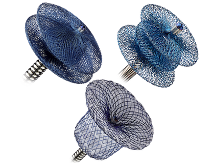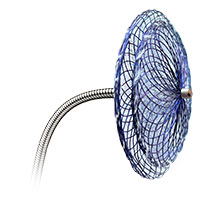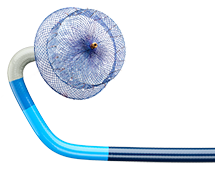The Amplatzer™ portfolio of structural intervention occluders provides minimally invasive treatment options for the closure of congenital heart defects and for stroke risk reduction. The closure procedures are performed through a transcatheter approach, which prevents the need for open heart surgery and enables faster recovery times.
The Amplatzer Family of Duct Occluders offers an extensive line of devices and a simple treatment option for the closure of patent ductus arteriosus (PDA). Amplatzer™ Duct Occluders are designed to occlude PDAs of various shapes and sizes. With an easy-to-perform deployment procedure, the implanting physician can be confident in placing the device with precision.

Amplatzer™ Septal Occluders are the standard of care for minimally invasive atrial septal defect (ASD) closure.1,2 These double-disc occluders are comprised of nitinol mesh and polyester material. They are designed to securely appose the septal wall on each side of the defect and create a platform for tissue in-growth after implantation.
Ventricular septal defects (VSD) are the most commonly found congenital heart defect.3 One subtype of these defects is muscular VSD. If left untreated it can lead to pulmonary hypertension and/or congestive heart failure.4 The Amplatzer™ Muscular VSD Occluders are designed for complete closure of these type of defects.
The Amplatzer™ Talisman™ PFO Occluder set the standard as the pioneering device developed specifically for patent foramen ovale (PFO) closure to reduce the risk of recurrent ischemic stroke.
With over 250,000 devices implanted and a legacy spanning over 25 years, it is the #1 device worldwide.4

The Amplatzer™ Amulet™ Left Atrial Appendage Occluder is designed to treat patients with non-valvular atrial fibrillation (AFib) who are at risk of ischemic stroke.
Its dual seal technology offers complete closure of the left atrial appendage and immediately eliminates the need for oral anticoagulants.6

The Amplatzer™ Valvular Plug III is specially designed to provide effective closure for patients with a wide range of paravalvular leak morphologies. By providing an effective solution to this key issue, the Amplatzer Valvular Plug III is improving life, quality and longevity to an increasing number of patients.5,7,8

MAT-2008012 v3.0 | Item approved for OUS use only.
You are about to enter an Abbott country- or region-specific website.
Please be aware that the website you have requested is intended for the residents of a particular country or countries, as noted on that site. As a result, the site may contain information on pharmaceuticals, medical devices and other products or uses of those products that are not approved in other countries or regions
Do you wish to continue and enter this website?
MAT-2305078 v1.0